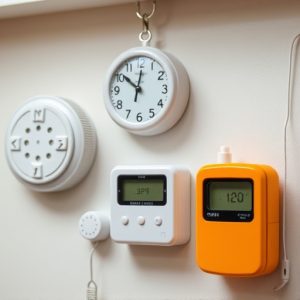Lone Worker Safety: Power of Compact, Loud Personal Alarms
Lone workers in high-risk industries face elevated physical harm and panic risks due to lack of supe…….
Lone workers in high-risk industries face elevated physical harm and panic risks due to lack of supervision. To mitigate these dangers, equip them with Loudest Compact Personal Alarm Devices (LCPADs) that serve as the most powerful signals for help. These portable devices enable quick alerts and rescues, even in remote or noisy locations. When selecting an LCPAD, prioritize high decibel levels (105-120 dB), easy activation, water resistance, long battery life, and thorough training on various emergency scenarios to ensure optimal protection. Successful implementations have shown significant improvements in well-being and operational efficiency for lone workers in isolated or hazardous environments.
In today’s diverse work environment, lone workers face unique challenges. The absence of immediate assistance amplifies risks, making it crucial to implement robust safety alert systems. This article explores critical aspects of lone worker safety, focusing on the role of a reliable Loudest Compact Personal Alarm Device. We delve into understanding the inherent dangers, the importance of such devices, essential features, effective implementation strategies, and real-world success stories, empowering employers and workers alike to stay safe.
- Understanding the Risks of Lone Working
- The Importance of a Reliable Personal Alarm Device
- Features to Look for in the Loudest Compact Personal Alarm
- Implementation and Training: Ensuring Effective Use
- Case Studies: Successful Safety Alert Systems in Action
Understanding the Risks of Lone Working
Lone workers, by definition, operate without immediate on-site supervision or backup. This can significantly heighten their exposure to a range of risks, from physical harm to isolated panic scenarios. Understanding these risks is the first step in implementing effective safety measures. In industries where lone working is prevalent, such as construction, forestry, and even healthcare, ensuring worker safety has become paramount.
One crucial component in mitigating these risks involves equipping workers with compact personal alarm devices that serve as a loudest signal for help when needed. These devices are designed to be easily portable, allowing workers to carry them at all times without hindering their tasks. In an emergency, they can quickly and reliably alert others to the worker’s location and distress, ensuring swift response and rescue.
The Importance of a Reliable Personal Alarm Device
In the event of an emergency, a lone worker’s ability to quickly and effectively alert others can be life-saving. This is where a reliable personal alarm device becomes indispensable. Unlike traditional alarms that are often confined to specific locations, a compact personal alarm designed for lone workers offers mobility and immediate attention when needed. Its loudest output ensures that help can be summoned promptly, even in the most remote or noisy environments.
The compact nature of these devices allows them to be easily carried or worn, enabling workers to have peace of mind knowing their safety is in their hands. They are designed for durability and reliability, standing up to harsh conditions and ensuring that when activated, they provide a distinct and attention-grabbing signal. This direct approach to personal safety is crucial for lone workers who might otherwise be unreachable or unable to communicate during an emergency.
Features to Look for in the Loudest Compact Personal Alarm
When choosing a Loudest Compact Personal Alarm Device, consider its decibel level as the primary safety feature. The alarm should emit a powerful and clearly audible sound, typically ranging from 105 to 120 decibels, to ensure it stands out above ambient noise and alerts others nearby. This high-intensity sound is crucial for getting immediate attention in an emergency.
Additionally, look for devices with versatile activation mechanisms, such as a simple push button or a durable rope pull, allowing users to activate the alarm quickly during distress situations. Water resistance and long battery life are also desirable traits, ensuring the device’s reliability in various environments and conditions.
Implementation and Training: Ensuring Effective Use
The successful implementation of safety alert systems for lone workers hinges on comprehensive training and fostering a culture of preparedness. It’s essential to equip employees with the knowledge to operate these systems effectively, especially compact personal alarm devices designed to emit the loudest sounds, ensuring they can promptly attract attention in case of emergencies. Training should cover scenarios where activation may be necessary, from accidental injuries to hostile situations, emphasizing practical applications for real-world effectiveness.
Regular drills and mock situations can enhance workers’ familiarity with the alert system’s functionalities, including testing range, signal strength, and response times. Additionally, providing clear guidelines on when and how to activate these alarms encourages proactive safety measures, empowering lone workers to take control of their well-being in remote or high-risk environments.
Case Studies: Successful Safety Alert Systems in Action
In recent years, numerous organizations have successfully implemented safety alert systems for lone workers, leading to significant improvements in employee well-being and operational efficiency. One standout example involves a remote construction team working on a steep mountain terrain. Armed with compact personal alarm devices, each worker could instantly transmit distress signals via a simple button press if they encountered any hazards. The loudest of these devices ensured that even in the midst of heavy machinery or strong winds, their alerts would be heard and responded to promptly by designated emergency contacts.
Another compelling case involves a solo park ranger patrolling vast wilderness areas. Equipped with a sophisticated personal alert system linked to GPS tracking, the ranger could quickly notify dispatchers of any unexpected situations or emergencies. This real-time communication facilitated swift rescue operations, as demonstrated in several life-threatening incidents where the system played a pivotal role in getting help to the ranger in time. These successful case studies underscore the value of integrating safety alert systems into lone worker protocols, enhancing not just survival chances but also operational continuity and peace of mind for individuals working in isolated or hazardous environments.
Lone workers face unique safety challenges, but with the right tools, these risks can be significantly mitigated. The implementation of a reliable Loudest Compact Personal Alarm Device plays a pivotal role in enhancing their security, as evidenced by successful case studies. When choosing an alarm, consider key features like high decibel levels, durability, and ease of use. Proper training and regular practice ensure that these devices are effectively utilized during emergencies, ultimately fostering a safer working environment for solo professionals.


